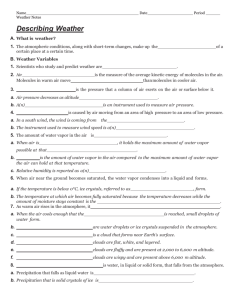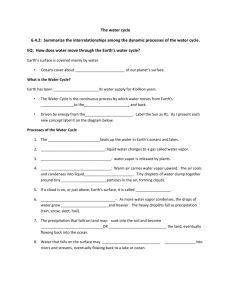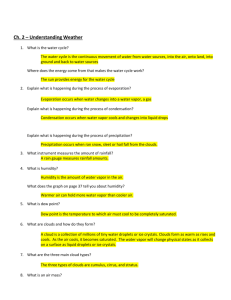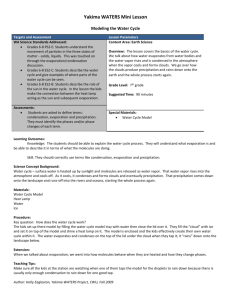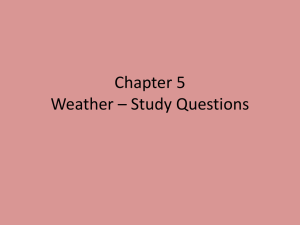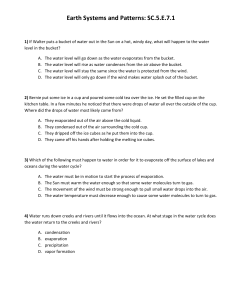Lesson 1: Describing Weather
advertisement
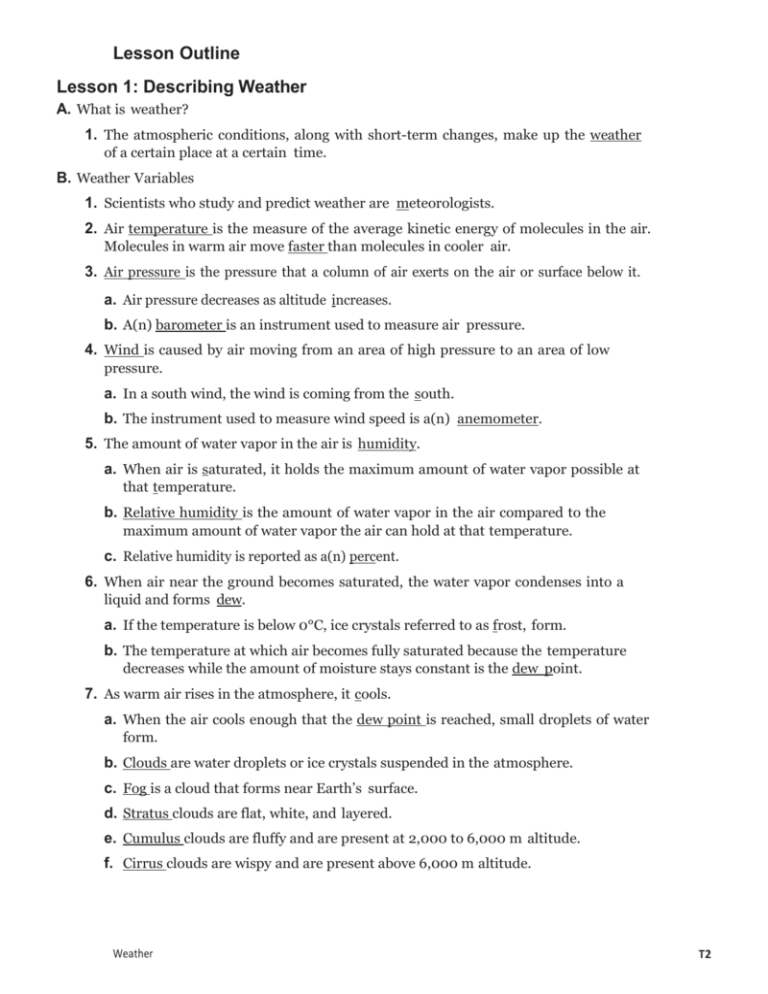
Lesson Outline continued Lesson 1: Describing Weather A. What is weather? 1. The atmospheric conditions, along with short-term changes, make up the weather of a certain place at a certain time. B. Weather Variables 1. Scientists who study and predict weather are meteorologists. 2. Air temperature is the measure of the average kinetic energy of molecules in the air. Molecules in warm air move faster than molecules in cooler air. 3. Air pressure is the pressure that a column of air exerts on the air or surface below it. a. Air pressure decreases as altitude increases. b. A(n) barometer is an instrument used to measure air pressure. 4. Wind is caused by air moving from an area of high pressure to an area of low pressure. a. In a south wind, the wind is coming from the south. b. The instrument used to measure wind speed is a(n) anemometer. 5. The amount of water vapor in the air is humidity. a. When air is saturated, it holds the maximum amount of water vapor possible at that temperature. b. Relative humidity is the amount of water vapor in the air compared to the maximum amount of water vapor the air can hold at that temperature. c. Relative humidity is reported as a(n) percent. 6. When air near the ground becomes saturated, the water vapor condenses into a liquid and forms dew. a. If the temperature is below 0°C, ice crystals referred to as frost, form. b. The temperature at which air becomes fully saturated because the temperature decreases while the amount of moisture stays constant is the dew point. 7. As warm air rises in the atmosphere, it cools. a. When the air cools enough that the dew point is reached, small droplets of water form. b. Clouds are water droplets or ice crystals suspended in the atmosphere. c. Fog is a cloud that forms near Earth’s surface. d. Stratus clouds are flat, white, and layered. e. Cumulus clouds are fluffy and are present at 2,000 to 6,000 m altitude. f. Cirrus clouds are wispy and are present above 6,000 m altitude. Weather T2 Lesson Outline continued 8. Precipitation is water, in liquid or solid form, that falls from the atmosphere. a. Precipitation that falls as liquid water is rain. b. Precipitation that is solid crystals of ice is snow. c. Precipitation that starts as snow and then melts and freezes again is called sleet. d. Hail is precipitation formed when ice pellets rise and fall within a cloud, adding new layers of ice during each cycle. 9. The water cycle is the series of natural processes in which water continually moves among oceans, land, and the atmosphere. a. Water enters the atmosphere as water vapor when liquid water on Earth’s surface evaporates. b. As water vapor cools, it condenses, forming liquid water. c. Clouds produce precipitation, which is when liquid or frozen water falls to Earth’s surface. Discussion Question Name and explain what happens during the three natural processes that form the water cycle. Liquid water evaporates into water vapor. Water vapor condenses to liquid water that forms clouds. During precipitation, liquid or solid water falls to Earth’s surface. Weather T3 Lesson Outline continued Lesson 2: Weather Patterns A. Pressure Systems 1. A(n) low-pressure system is a large body of circulating air that has low pressure at its center and higher pressure on the outside. a. Air moves from high pressure to low pressure. b. In a low-pressure system, air moves away from the outside of the system. c. Air in the center of the system rises, and the water vapor in it condenses and forms clouds. 2. A(n) high-pressure system is a large body of circulating air that has high pressure at its center and lower pressure on the outside. a. High-pressure air at the center sinks and moves toward low-pressure areas. b. High-pressure systems bring clear skies. B. Air Masses 1. Air masses are large bodies of air that have distinct temperature and moisture characteristics. 2. An air mass forms when a(n) high-pressure system lingers in one area for a few days. a. Continental polar air masses are cold and dry. b. Maritime tropical air masses are warm and humid. c. Arctic air masses are very cold and dry. They form over continents or arctic ice. C. Fronts 1. A weather front is the boundary between two air masses. 2. A(n) cold front forms when a colder air mass moves toward a warmer air mass. It often brings severe storms and cooler temperatures. 3. A(n) warm front forms when a warmer air mass moves toward a cooler air mass. a. As the warm air rises, water vapor condenses, and precipitation often occurs. b. A warm front brings warmer temperatures and shifting winds. 4. A(n) stationary front forms when the boundary between two air masses stalls. It brings cloudy skies and light rain. D. Severe Weather 1. A low-pressure system can provide the warm temperatures, moisture, and rising air needed for a(n) thunderstorm to form. a. The cumulus stage of a thunderstorm starts with cloud formation and updrafts. b. The mature stage of a thunderstorm contains heavy winds, rain, and lightning. Weather T4 Lesson Outline continued c. During the dissipation stage of a thunderstorm, wind and rain subside. d. Lightning is caused by oppositely charged particles in clouds and on the ground. 2. A violent, whirling column of air that contacts the ground is a(n) tornado. a. Tornadoes form when updrafts from thunderstorms begin to rotate. b. Tornado Alley is the name for the part of the United States that has the most tornadoes. 3. A(n) hurricane is an intense tropical storm with winds exceeding 119 km per hour. a. Hurricanes typically form in late summer over warm, tropical oceans and are the largest type of severe storm. b. When a hurricane moves over land or cold water, it loses energy. 4. A(n) blizzard is a severe winter storm, characterized by freezing temperatures, strong winds, and blowing snow. 5. The U.S. National Weather Service issues a(n) watch when severe weather is possible. It issues a(n) warning when severe weather is already occurring. Discussion Question Which types of severe weather are common where you live? Which features of Earth’s surface where you live make this severe weather common? Answers should relate temperature and proximity to bodies of water, mountains, or deserts to severe weather. Weather T5 Lesson Outline continued Lesson 3: Weather Forecasts A. Measuring the Weather 1. Meteorologists measure weather variables before making a forecast. 2. A(n) surface report describes a set of weather measurements made on Earth’s surface. 3. Measurements include temperature, air pressure, humidity, precipitation, and wind speed and direction. 4. A(n) upper-air report describes wind, temperature, and humidity conditions above Earth’s surface. 5. A(n) radiosonde is a package of weather instruments that are carried into the atmosphere by a weather balloon. 6. Satellites provide weather information by measuring the radiation given off by Earth and by taking photographs. 7. Infrared satellite images provide information about cloud temperature and height. 8. Doppler radar is a special form of radar that can be used to detect precipitation and approximate wind speed. B. Weather Maps 1. The station model displays many weather measurements for a specific location. It appears on weather maps. 2. Weather maps have isobars, which are symbols made up of lines that connect places that have equal air pressure. These lines give information about wind speed. 3. Isotherms are lines that connect places that have the same temperature. 4. Fronts are represented as lines with symbols on them. C. Predicting the Weather 1. Modern weather forecasts are made with the help of computers. 2. Computer models are detailed computer programs that solve a set of complex mathematical formulas. The formulas predict temperature, winds, precipitation, and types of clouds. Discussion Question Look at a forecast of today’s weather. How does the actual weather compare with the forecast? Students should compare wind speed, temperature, precipitation, and other factors. Weather T6

